Chinese Dynasty: Han Dynasty Part I - the Western Han (202 BCE – 8 CE)
The Western Han Dynasty (西汉, Xī Hàn) was one of the most significant and influential dynasties in ancient China, ruling from 206 BCE to 9 CE. This period saw significant developments in Chinese culture, politics, and technology, laying the foundation for the future prosperity of the nation. In this article, we will explore the history, culture, and achievements of the Western Han Dynasty.
The Rise of the Western Han Dynasty
The Western Han Dynasty was founded by Liu Bang (刘邦), a rebel leader who was part of coalition forces that overthrew the ruling Qin Dynasty (秦, 221 to 206 BCE).
Liu Bang was born into a peasant family and worked as a minor government official before joining a rebellion against the Qin Dynasty. After the fall of Qin in 206 BCE, Liu Bang emerged as the leader of a coalition of rebel forces and established the Han Dynasty in 202 BCE.
Chu-Han Contention
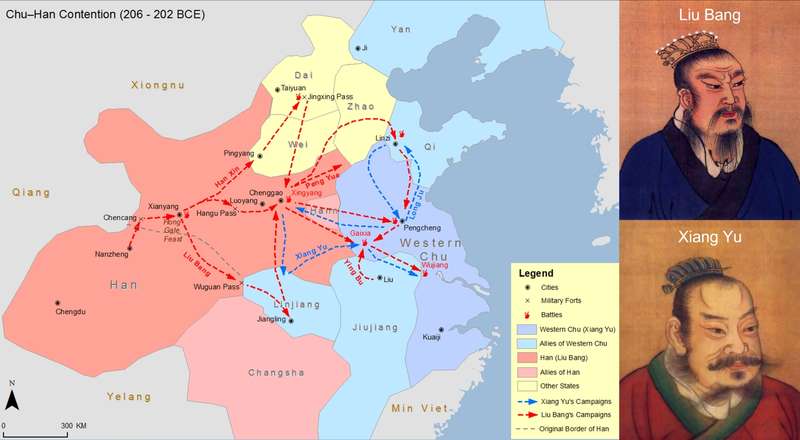
Left: the Chu Han Contention. Right: portraits of Liu Bang and Xiang Yu.
Before establishing the Han Dynasty and becoming known as Emperor Gaozu (汉高祖, Hàn Gāo Zǔ), Liu Bang went through a long and difficult struggle for power, even after the collapse of Qin.
In 209 BCE, Liu Bang joined a rebellion against the Qin Dynasty with Xiang Yu (项羽), who was a noble of the former Chu state (楚国) who became a powerful warlord.
Liu Bang and Xiang Yu led two different rebellion forces that defeated the Qin Dynasty. Xiang Yu was enthroned as the Hegemon-King of Western Chu (西楚霸王), while Liu Bang was forced to accept the remote Bashu region (巴蜀, present-day Sichuan, Chongqing, and southern Shanxi) and titled as the King of Han (汉王).
Since then, Liu Bang and Xiang Yu engaged in a civil war known as the Chu-Han Contention (楚汉之争), which was a four-year-long conflict for power. Liu Bang eventually defeated Xiang Yu at the Battle of Gaixia (垓下之战) in 202 BCE, which concluded with Xiang Yu's suicide, marking the end of the Chu-Han war and the beginning of the Han Dynasty.
Establishment and Early Reign of Western Han
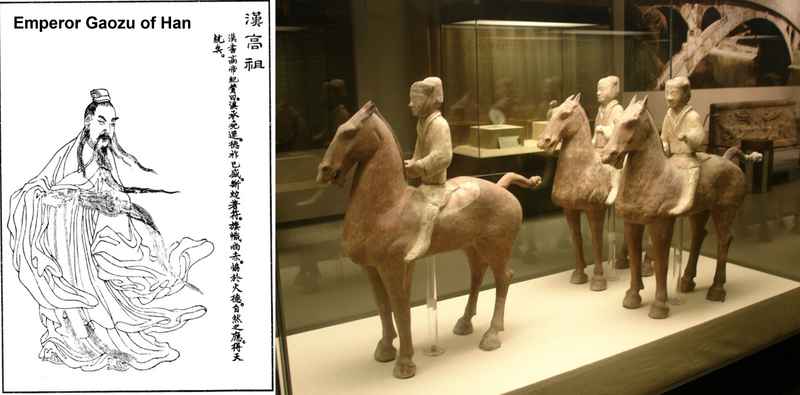
Left: a portrait of Han Gaozu. Right: ceramic status of the Han military.
Liu Bang declared himself emperor and established the capital at Chang'an (长安, present-day Xi'an) after the conclusion of the Chu-Han Contention.
He adopted the "commandery and feudal system" (郡国制), in which commanderies and feudal states coexisted. The central government implemented the same system as the Qin Dynasty, while local governments adopted the system of feudal enfeoffment. The emperor enfeoffed some princes as feudal lords or kings, with the former only enjoying the tax revenue from their fiefs and no military or administrative power, while the latter had independent political and military power.
Internally, the Han Dynasty made great efforts to the development of water conservancy, reduced and exempted taxes, and created favorable conditions for the restoration of agriculture.
Externally, the Han Dynasty formed a marriage alliance with the Xiongnu (匈奴), a confederation of nomadic tribes in the north, to maintain peace in the border regions.
The early policies of Han had a significant effect on the economic recovery but also resulted in some drawbacks. The policy of light taxes and burdens caused some local powerful families to become stronger and resulted in land consolidation. In addition, the frequent invasions of the Xiongnu became a threat to the Han Dynasty.
In terms of politics, Liu Bang first granted the titles of kings to his deserving generals, including Han Xin (韩信), Peng Yue (彭越), and Ying Bu (英布). However, in his later years, he became suspicious of some of the meritorious kings who were not part of the royal Liu family. He canceled their titles under various pretexts to prevent rebellion and consolidate imperial power. He replaced them with his own relatives and established a pledge that "anyone who becomes a king but is not the Liu family will be jointly attacked" (Chinese: "非刘氏而王者,天下共击之"——白马之盟).
The Political System
The Western Han Dynasty was governed by a centralized monarchy headed by an emperor and supported by an elaborate structure of imperial administration, known as 三公九卿 in Chinese (see below), which was patterned after its predecessor, the Qin Dynasty.
The emperor held ultimate power as the supreme judge, lawgiver, and commander-in-chief of the armed forces. The emperor also had the authority to appoint officials to top posts in central and local administrations.
Below the emperor were his cabinet members, which were known as the Three Councilors of State (三公, sān gōng). Among them, the Chancellor (丞相, chéng xiàng), also known as the Minister over the Masses (大司徒, dà sī yú), was responsible for drafting the government budget, managing provincial registers, leading court conferences, acting as a judge in lawsuits, and recommending nominees for high office. The Imperial Counselor (御史大夫, yù shǐ dà fū), also known as the Excellency of Works (大司空, dà sī kōng), was in charge of conducting disciplinary procedures for officials and overseeing public works projects. The Grand Commandant (太尉, tài wèi), also known as the Grand Marshal (大司马, dà sī mǎ), was the commander of the military and regent during the Western Han period. However, during the Eastern Han era, this was mainly a civil official with similar censorial powers as the other two Councilors of State.
Below the Three Councilors of State were the Nine Ministers (九卿, jiǔ qīng) and they each headed a specialized ministry.
Military
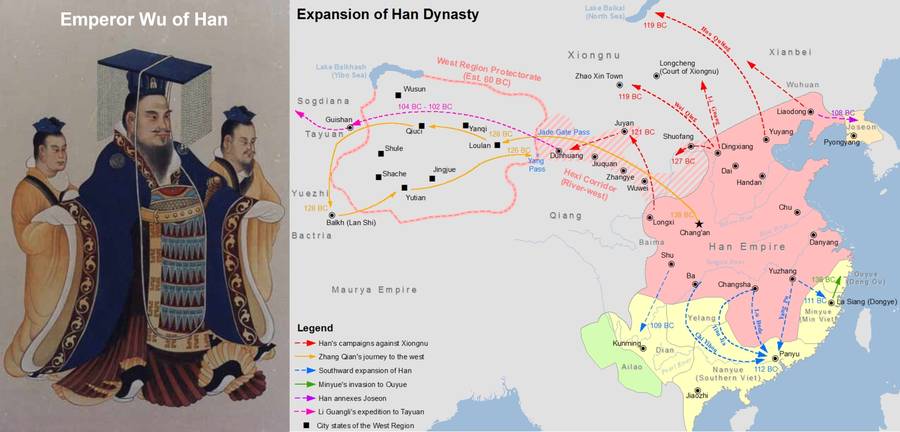
Left: a portrait of Emperor Wu of Han. Right: map of Han's expansion.
The Western Han Dynasty faced significant challenges in its early years, as Liu Bang and his successors had to consolidate their power and suppress rebellions and uprisings. One of the most significant rebellions was the Rebellion of the Seven States (七国之乱), which occurred in 154 BCE during the reign of Emperor Jing of Han (汉景帝). Seven regional warlords rebelled against the central government, but the Han managed to defeat them and reassert their control over the empire.
Throughout its history, the Western Han Dynasty continuously faced external threats from neighboring states, particularly the Xiongnu. The Han Dynasty initially tried to appease the Xiongnu by paying tribute but eventually had to resort to military force to protect its borders. The most famous military campaign against the Xiongnu was led by Emperor Wu of Han (汉武帝), who launched a series of expeditions to the north in the second century BCE. These campaigns were successful in expanding Han territory and securing the northern border but also put a strain on the economy and military resources of the empire.
Culture and Society
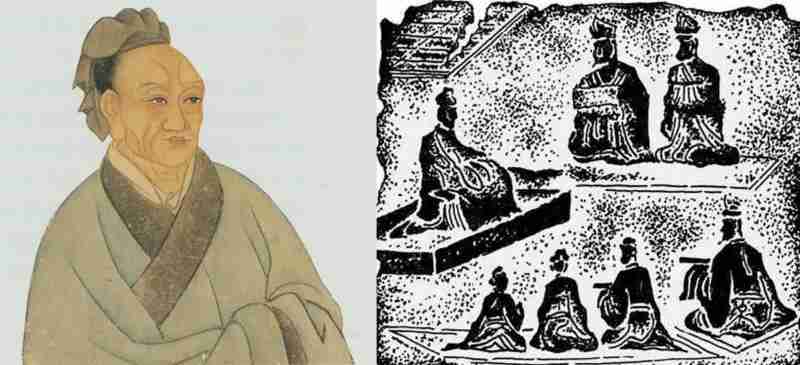
Left: a portrait of Sima Qian. Right: an illustration of a Confucian lecture in the Han Dynasty.
The Western Han Dynasty saw significant developments in Chinese culture and society. Confucianism (儒家/儒学), which had been suppressed during the Qin Dynasty, was revived and became the dominant philosophy and ethical system of the Han Dynasty. It shaped the values and beliefs of the ruling elite and the general population. Confucian scholars were appointed to important government positions and played a significant role in shaping government policy and promoting social harmony and moral values.
As for religion during the Western Han period, the original purpose was to strengthen the emperor's power. Through the constant efforts of Confucian scholars, by changing the locations, rituals, and main deities of worship, the state religion was politically ethicized at the end of the Western Han period. It also regained its secular function, thus becoming a religious tool for maintaining imperial rule.
In the late Western Han period, Buddhism was introduced to China.
The Western Han Dynasty also saw significant developments in literature, art, and science. The historian Sima Qian (司马迁), who lived during the Western Han Dynasty, wrote the monumental Records of the Grand Historian (《史记》), a comprehensive history of China from the earliest times to the Han Dynasty. This work set a standard for historical writing in China and influenced future historians and chroniclers.
The most ancient Chinese works in mathematics were written during the Western Han Dynasty, including The Nine Chapters on the Mathematical Art (《九章算术》) and Zhoubi Suanjing (《周髀算经》).
The social structure of the Western Han Dynasty was hierarchical, with the emperor at the top and commoners at the bottom. However, social mobility was possible through education and merit-based examinations.
During the early Western Han Dynasty, officials were mainly selected based on their military achievements or their position as a part of the emperor's staff. However, this system didn't produce the most qualified officials, and talented people had a hard time being selected.
Emperor Wu of Han (汉武帝) introduced new methods of selecting officials to strengthen his rule. He implemented the "Selection and Recommendation" system (察举制), which selected officials based on their ability rather than their social status or wealth. Additionally, talented individuals who refused to serve could be recruited through the "Summoning" system.
Emperor Wu also established the Imperial Academy and instituted the practice of selecting officials based on their performance in exams. This system was expanded in later dynasties and became the main pathway to government service.
Economic Achievements

Left: an illustration of Zhang Qian's Mission to the Western Regions. Right: images of Five-baht Coins.
The Western Han Dynasty is considered one of the most prosperous periods of ancient Chinese history. During this era, the Chinese economy enjoyed tremendous growth and development, which had a lasting impact.
Agriculture was the backbone of the Han economy. The Han Dynasty introduced new agricultural technologies, such as the iron plow and crop rotation, and new irrigation systems were built, all of which significantly increased food production. The government also implemented policies to support agriculture. For example, the early Han government ordered the prohibition of killing and stealing cattle and set up gardens to raise horses on the northern border. This move made cattle farming, supplemented by horse farming, became popular, especially in the Yellow River Basin.
Overall, under the Han, agriculture became more efficient and productive, leading to a surplus of food. This in turn fueled population growth and economic development.
The Western Han Dynasty was known for its extensive trade networks, which extended to neighboring regions such as Central Asia and Southeast Asia. During the reign of Emperor Wu of Han (汉武帝), Zhang Qian (张骞) was sent on missions to the Western Regions (西域) and established the Silk Road (丝绸之路) linking Eurasia, and the silk trade between Europe, Asia, and Africa took shape. The Silk Road facilitated the exchange of goods and ideas between the East and the West. This trade network was vital to the economic development of the Han Dynasty and contributed to its wealth and prosperity.
With the development of agriculture and handicrafts, commerce prospered. During the Western Han Dynasty, several economic regions had been formed across the country, and each region had a large metropolis. Constraints on merchants were also gradually relaxed since the establishment of the Han, creating conditions for the prosperity of commerce.
During the reign of Emperor Wu, he brought important industrial and commercial departments such as iron smelting, salt cooking, and winemaking monopolized by the private sector into the state monopoly. At the same time, he also implemented policies of "equalization" (均输平准), that is, the adjustment of transportation and the balance of prices.
In addition, Emperor Wu prohibited counties and states from minting coins and returned this power to the central government. He established a special minting institution to be responsible for minting five-baht coins (五铢钱), which were easy to circulate and became the only legal currency at the time. This move promoted the social and economic development of the Western Han Dynasty.
The Western Han Dynasty made significant advancements in technology, which had a profound impact on the economy as well. The development of iron smelting techniques allowed increased production of iron tools, which facilitated the widespread use of iron tools and weapons, and it led to increased efficiency in agriculture and other industries. The government also promoted the development of handicraft industries, such as silk weaving and pottery making. Especially silk, which became a valuable export and contributed to the wealth of the empire.
The Western Han Dynasty also invested heavily in infrastructure, which facilitated economic growth. The government-built roads, canals, and bridges improved transportation and facilitated trade. The continued construction of the Great Wall of China (长城), which began during the Qin Dynasty, provided protection for the empire from the northern nomadic tribes.
Legacy
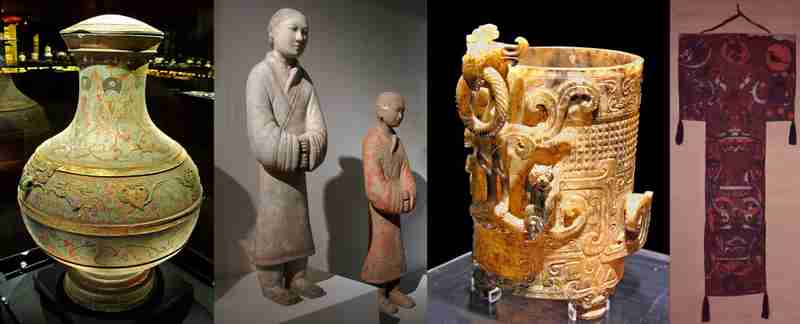
Items and artifacts showing Western Han achievements
The legacy of the Western Han Dynasty is profound and far-reaching, and it had a significant impact on Chinese history and culture. The dynasty's centralized bureaucratic system of government became the model for future dynasties, and its emphasis on Confucianism as the dominant philosophy and ethical system shaped Chinese values and beliefs for centuries to come.
The Western Han Dynasty also played a critical role in expanding Chinese territory and influence. The dynasty's military campaigns against the Xiongnu and other neighboring states led to the expansion of Han territory and the establishment of a network of trade routes known as the Silk Road. This network of trade routes linked China to the Middle East and Europe and facilitated the exchange of goods, ideas, and culture between different regions of the world.
The dynasty's cultural and intellectual achievements also had a lasting impact on Chinese civilization. The revival of Confucianism as the dominant philosophy and ethical system reinforced the importance of education and scholarship, which became the hallmark of Chinese intellectual culture. The advances in literature, art, science, and technology laid the foundation for future innovations and intellectual developments in China.